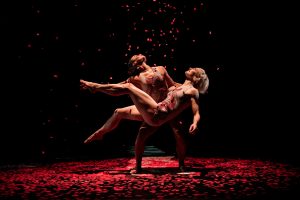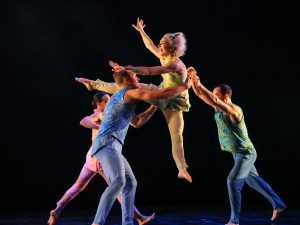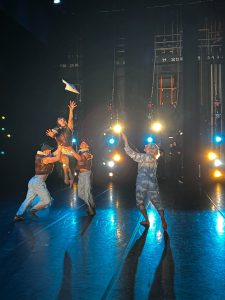
Even for an arts organization as renowned as Pilobolus, dealing with audience expectations must be a hurdle.
People who have seen the company perform numerous times naturally arrive at the theater with a certain set of expectations. Meeting those expectations time after time must be a difficult task. New works give vitality to a company but often it is the tried-and-true works that keep the audiences coming back in order to experience that same thrill once again.
Pilobolus’s programs are often filled with zany props, intriguing theatrics and jaw-dropping physicality and thus exceed anyone’s expectations. Audiences leave wanting more of the same. As trailblazers in the 1970s, Pilobulus’s unique form of dance has etched an indelible mark on dance history not only for its wonderfully impossible physicality onstage but also for the collaborative way the company creates its dances.
It was no surprise that before the show began Jan. 31 at the Duncan Theatre in Lake Worth Beach that there was an air of excited anticipation. The audience at this Modern Dance Series is a loyal and savvy group of dance enthusiasts and most — like me — had probably seen Pilobolus perform the four previous times it had been featured in the series.
To highlight its 50th year, the company is touring an evening-length retro program titled re:Creation. The Duncan Theatre program was composed of five dances that were selected from a grouping of 17 old and new works that form the repertory for re:Creation. The title seemed very appropriate, as the company has a history of being a cauldron of creativity. All the works are created by the dancers through guided improvisation by the artistic directors; in the program, the dances are listed as created by and not as choreographed by. The names of all the past and present dancers — as well as other artists involved in the creation of a piece — are recognized and listed.

Giving the title another look, one could say that the older works are therefore always in a state of re-creation, and that the actual performance itself serves as a recreation as in the noun — a pastime or diversion affording relaxation and enjoyment.
Hannah Klinkman teamed up with the company’s newest dancer, Jessica Robling (who joined the company just six months ago), performing Bloodlines, a pure and elegant duet that, according to the pre-curtain intro by Executive/Co-Artistic Director Renée Jaworski and Artistic Director Matt Kent, was about intergenerational caretaking. Wearing flesh-colored leotards with painted red lines that resembled internal organs designed by Márion Talán del la Rosa, the duet was filled with supportive partnering and cantilevering lifts wthat the two women seemed to execute effortlessly.
The opening moment was simple and effective. The women — one blond, one brunette — were face-to-face in an embrace and began to slightly lift the other off the floor in a half-revolution, traveling slowly through the stage space. Arriving under an overhead spotlight where red confetti fluttered downward, they began to fully carry the burden of the other’s weight, often suggesting the lamentation pose of the Pietà. It was an intimate opening work with a trademark look that set a polished tone to the program.
Unfortunately, following this work there was a long pause where the audience sat in darkness until people pulled out their phones to pass the time by browsing. Clearly the mood the two dancers had established was disrupted.
The next dance, Awaken Heart, did little to reengage us even with the advantage of the added footnote from the pre-curtain introduction that it was about the transient and fragile quality of relationships. Two men, Connor Chaparro and Sean Langford, joined the two women for a double duet danced to the music by Michael Wall. Wearing understated, pastel tunic tops and pants by Valerie St. Pierre Smith, the dancers met and parted in a pure dance piece that was pleasant enough but seemed a bit flat and milquetoast for a Piloblolus program. However, the lighting design by Diane Ferry Williams added a nice element to the work as it evolved during the dance and at one point in an unusual effect, the sidelights were an array of subtle, dappled rainbow colors, and the dark dance floor transformed into a monochromatic textured pattern.
Finishing up the first half of the program was an older work, Tales From the Underworld, which had an interesting clarinet score by collaborator and musician Stuart Bogie. The cast of six included the other two company members, Quincy Ellis and Darren Robinson. There was a vague dreamlike subplot of a couple, Robling and Chaparro, exchanging a white lily and being separated during a kiss by other worldly forces. A huge gossamer scarf was an eerie prop that was used to keep the couple separated, sometimes looking like a billowing cloud and other times looking like death that had wrapped around Robling embalming her face and body.

Friday night was the world premiere of Flight, which was the simplest and most lighthearted work presented. It had its charm as it was reminiscent of the Peanuts cartoons featuring Snoopy and the Red Baron. The costumes for the aviator trio designed by Talán del la Rosa added a cute touch. Robling was the central character and wore the aviator googles and brown leather helmet of the Red Baron while Chaparro and Robinson wore aviator vests and black baseball hats with propellers attached to the top. The trio began playing with large white paper planes while running around imaging the sensation of flying. Later, by balancing Robling on a pole held by the two men, they simulated flight as they raced forward making motor sounds trying to get her to take off.
Klinkman, dressed in work overalls, was onstage at various times during Flight. Her only task was to arrange and rearrangethe white fluff piles that were supposed to be clouds. These pedestrian moments were long-winded, especially when she returned and collected all the cloud bits and put them in front of two large black fans (which had been in view the entire time) so that they would be hidden for the ending tableau. Needless to say, when Robling as the Red Baron was finally airborne and suspended above the cloud with a long gossamer scarf blowing in the wind behind her, it was anti-climatic. The wind effect had an obvious source, and wasn’t that the exact same gossamer scarf from Tales From The Underworld? For a world premiere, Flight had an unfinished air about it.
The evening ended with the full-company work, Branches. Created in 2017 as a commissioned work by the Jacob’s Pillow Dance Festival and the National Endowment for the Arts, it was what the audience was waiting for. It was trademark Pilobolus, with its quirky humor and zany athletic moves that managed to easily engage the audience with the lifeforms of some exotic location. Led by the energetic Ellis, the dancers transformed into flora and fauna bounding around to a variety of jungle sounds. It was a delightful celebration of the natural world and the audience responded by now upping their previous tepid applause to enthusiastic. It was the last work presented but it managed to meet some of the audience’s expectation of what they hoped they would experience at a Pilobolus performance.
From the moment you enter the theater, the company has a knack for inviting the audience into their world. It is intentional. As the audience is being seated, the curtain is open so that there is no barrier between performer and viewer. The audience can partake in the dancers’ pre-curtain world of warming up and kidding around with each other. They can read the dancers’ bios in the program, which are quite idiosyncratic. They can learn about the non-dancer part of the dancers’ lives such as the name of their dogs or that they love houseplants or hiking.
Then in front of the curtain before the show begins, there is a relaxed meeting with the leadership team where they tell the audience a bit about the company and what to expect. There is also a Q-and-A after the performance where the audience can actually talk with the dancers and directors. This sense of ease, dedication and sincerity resonates in the collaborative works they create and perform.
I didn’t think the choice of repertory chosen for the Duncan Theatre version of re:Creation worked as well as the other repertory programs I have seen in past seasons. It was a more dancerly program. There were no props — no quadcopter, no shadow play, no magic shows, and no sculptures on a pedestal that came to life. I found myself missing the Pilobolus high I had expected to have. Still, when I left the theater, I knew that I would be back to see the next creative cauldron Pilobolus produces.